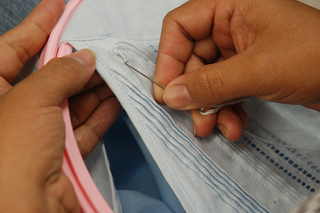COLOMBIA
COLOMBIA

The municipality of Cartago, in the department of Valle del Cauca, has many reasons to be called the “Capital of Embroidery”. It is known nationally and internationally for excellent textile works by Colombian artists – true masters of needle and thread.
Cartago embroidery has been developing since the 16th century. The art is transmitted from one generation to the next. Thus, grandmothers, mothers, and daughters devote themselves to this artisan textile industry and embellish with their work blouses, skirts, pants, ruanas (Colombian ponchos), and guayaberas (pleated and embroidered shirts of the Caribbean region).
History of Cartago Embroidery
The art of embroidering originated in the Hispanic-Arab heritage. Spanish women adopted the custom of decorating the sleeves, collars, and fronts of shirts during the conquest of the Iberian Peninsula. In turn, the Spanish conquistadors brought the first hand-embroidered items to the American continent, including Cartago, a city they founded in 1540.
Hand embroidery became an institution in 1890 when the Vincentine sisters began to teach it in the school they ran. At the beginning, in colonial times, Spanish women were responsible for continuing the art of embroidery, and they did so by embroidering shirts with thread the same color of the material. This type of embroidery was very elegant and rather inconspicuous.
Later on, mestizo women adapted the tradition and began to use thread of different colors, thus imparting a new touch, very characteristic of this land. They devoted themselves to the activity of embroidering and began to establish small family enterprises that gradually obtained national and international acknowledgement and fame.
Characteristic Motifs of Cartago Hand Embroidery
Lately, natural materials from the Colombian flora, mainly fibers from banana leaves and sisal, are being added to traditional embroidery and have become fashionable in the textile industry.
The most characteristic elements used by Cartago embroidery for a long time are inspired by the flora of the northern part of Valle del Cauca. Many motifs are flowers and geometric motifs coming from Andalusian embroidery.
Cartago Embroidery Techniques
Cartago embroidery utilizes the following techniques:
Pass Stitch:
This technique uses short, staggered stitches and covers large embroidery areas. A thread comes out at A, a straight stitch on the central line of the motif. The thread will come out again at B to make a diagonal stitch on the central line at the base of the first stitch. Then the thread comes out at C, and a similar bias stitch is mounted on the latter. The procedure continues on each side of the motif until it is filled in.
Running stitch:
The needle and thread are passed over and under the cloth, with the top stitches all the same length; the under stitches must also be the same length, but half the length of the over stitches.

Cartago Embroidery
Photo by: Mario Carvajal
Bite stitch:
This type of embroidery owes its name to the fact that the stitches are of unequal size. It is frequently used to fill in a motif that is either too large or too irregular to cover with embossing stitches. It is also used to achieve a shade effect. The first time around, long and short stitches alternate very close together, following the shape of the motif. After that, the rounds are done in such a way that they present a gentle appearance.
Chain stitch:
Bring the thread up at the top line and hold it down with the left thumb. Insert the needle where it last emerged and bring the point out a short distance away. Pull the thread keeping it under the point of the needle.

Cartago Embroidery
Photo by: Mario Carvajal
Cord stitch:
Bring the thread out at A, with a small stitch over the line of the drawing, and opening the thread with the needle. The cord is used to fill in fine, flat surfaces.
Double durning stitch:
This technique is used for shading fine, transparent materials. It may be done from either the overside or the underside. The stitches are made alternately from one side to the other of the motif and are delicately seen through the material.
Rococó:
A stitch is made at a distance equivalent to the measurement desired for the “rococo”, bringing out only the point of the needle at the place where it was brought out initially. The thread is then wound around the point of the needle as many times as is necessary to cover the desired space. The rolled thread is held in place with the left thumb and is crossed by the needle. Still holding the rolled thread, the needle is turned around and inserted in the same place. Then the thread is pulled to the location of the initial stitch. A small-eyed needle must be used in order to pass easily through the rolled thread.

Cartago Embroidery
Photo by: Mario Carvajal
French knots:
Bring the thread out at the required position holding it down with the left thumb and encircle it twice around the needle. While holding the thread firmly, twist the needle back to the point where the thread first emerged. Pull the thread back and finish off if only one French knot is desired or go on to make the next knot.
Guided tour of the Cartago Embroidery factory
The city of Cartago offers more than the possibility of shopping for precious hand-embroidered items. Frixio, one of its embroidery factories, offers guided visits of its entire plant. Thus, tourists may observe the whole process, from patterning to cutting, sewing, embroidering, ironing, etc.
The tour ends with a visit to their boutique.



















